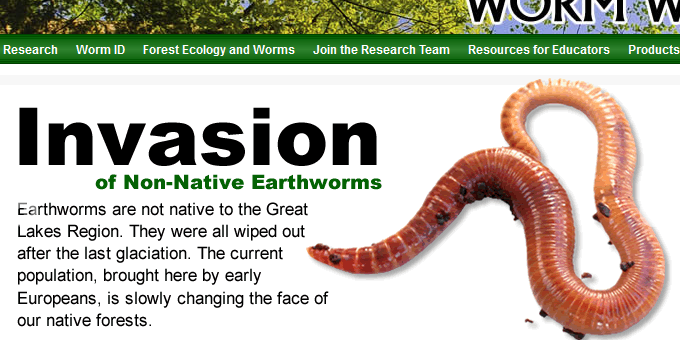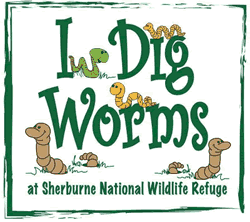Great Lakes Worm Watch
By Liza Lester, ESA communications officer.

RYAN Hueffmeier wants to talk to you about the humble earthworm. Trusty fish bait, friend to schoolchildren, gardeners and composters, the earthworm is no friend to the hardwood forests of the Great Lakes. It is a European invader, and its decomposition services, well known to gardeners, are not helpful to the forest ecosystems that have evolved without them. Hueffmeier is program coordinator for Great Lakes Worm Watch, a citizen science project based at the Natural Resources Research Institute at the University of Minnesota, and he is well versed in explaining the earthworm situation to audiences of a broad range of ecological and vermicological familiarity.
There are no earthworms native to the northern reaches of North America. Land that lay under heavy ice during the last ice age lost any worms it may have had (the fossil record is thin on soft-bodied creatures). Native earthworms do trawl the soils farther south, but their advance is slow; they had not re-colonized the upper Midwest and Canada at the time Europeans began to colonize North America. Researchers suspect the worms hitchhiked across the Atlantic in the ballast of ships and the root balls of imported shrubs.
Earthworms have now arrived in the Great Lakes vicinity—not everywhere, some earthworm-free places remain, but the worms are spreading, and humans are their vector. Ecologists can sometimes see the advance of the worm front in the drought-like symptoms of infested forests. The European species seem to do well everywhere they go, even pushing into the historical territory of native earthworms. To understand how earthworms affect the ecosystems of the Great Lakes, it would be great to know where the worms are and are not, and in what abundance and species variety. But sampling all of Minnesota, Wisconsin, Michigan, New York, Ohio and Indiana is a vastly labor intensive task.
“The beautiful thing about citizen science is that you can get a lot of people to collect a lot of data,” said Hueffmeier. UM researcher Cindi Hale chartered the project in 2000 as Minnesota Worm Watch, and it has expanded to the entire Great Lakes region and beyond. They now have so much data that the problem has become how to organize and display it without a dedicated data manager on the job. By next year, they hope to have developed a more muscular interactive map, interconnecting different kinds of information. But their website has plenty of information and project ideas to poke through already— and there is still plenty of territory to cover on the way to understanding earthworm ecology and gaining public help in managing the spread of the worm.
In the ten thousand or so years since the retreat of the ice, the ecosystems of the Great Lakes region and other northern climes have adapted to the absence of the worm, and to their own, microbial decomposers. The microbes don’t work as fast or with the same mobile style as the earthworms, and so the soil texture, structure, and chemical make-up is different. Leaf litter, bark and other organic debris blanket the forest floor in a thick mulch of slowly decomposing “duff” that slowly releases nitrogen and other nutrients to the deeper roots and soil reaches.
Newly arrived earthworms eat through the duff in a few seasons, replacing it with the rich, black soil that is so good for your garden. But it isn’t so good for the plants that are not adapted to it, and they tend to lose out in competition with exotic plants that can really take advantage of it.
Without the buffering layer of duff, the forest floor is vulnerable to bigger fluctuations in temperature and humidity. Water runs through the system faster, making the soil below both wetter (during storms) and drier (between storms, without the duff to retain the rain). Nutrients wash through the topsoil before plants can take them up, and root systems shrink. The net effect of the earthworms’ soil churning in hardwood forests around the Great Lakes is, counter-intuitively, compaction of the soil. As native forest ground cover diminishes, ground nesting birds like thrushes lose habitat and the earthworm effects cascade outward.
To learn about patterns of earthworm spread and ecosystem response, Worm Watch recruits the public to help gather data. For the most basic observations, data-gathers pour a mix of water and ground mustard seed over a standardized plot, encouraging any earthworms present to surface, and record presence/absence and the GPS location. The program invites participation on a continuum of time investment, from simple observations, to collecting and submitting specimens, to organizing a study site.
Sue Hix is a retired banker, president of the Friends of Sherburne National Wildlife Refuge, and local Worm Watch leader. When I talked with her in late February, she was just in from the refuge, warming up after leading a group of first graders around a small part of its 30,700 acres.
The Sherburne group teaches Worm Watch’s program to all ages, tailoring it for first graders on up to high schoolers and adults. The program is new, but already attracting visitors and getting them down and dirty with the soil and living creatures of the refuge.
“You really have to practically get your nose in the ground, because when the worms come up, you kind of have to grab them and pull them out gently without breaking them,” Hix said. In the leaf litter, the worms are small and hard to see. Hix said the program is perfect for the flexible minds and bodies of kids: “They like wiggly things, and their knees don’t hurt!”
The Friends of Sherburne received a Nature of Learning grant for Worm Watch from the National Fish and Wildlife Foundation in July, completed a workshop with Hueffmeier in August, and launched the program during their Wildlife Festival in September. Bemidji State Masters student Jessica Johnson added impetus to get the program going, and has been developing curricula to accompany the Worm Watch materials, but the program runs on volunteers.
“You have to go out and market it, and make connections with schools,” said Hix. Their work has paid off, and the program is verging on drawing more interest than its volunteers can handle.
Since the September debut, the ground has gotten cold and hard, but Sherburne’s volunteers still have local kids coming out to the refuge to learn about where earthworms come from, how they got to Sherburne, how they spread, and how they affect the landscapes they spread into.
“We did four classroom sessions with a high school class last week. The ground is frozen, but they did come out to the refuge and learn about habitats,” said Hix.
Sherburne NWR is a mixture of prairie, savanna, woodland and wetland in a rural area about 50 miles northwest of Minneapolis, and is itself reclaimed farmland. The program there has produced the first Worm Watch data from Sherburne County, and Hix and her colleagues have barely scratched the surface of what the refuge has to offer. Hix says the scientists are interested in the variety of terrain in the refuge, and how the worms fare in the different environments. But for Hix the biggest draw of the program is that it brings people out to learn about the refuge, and all of the biology within it.
Bringing people to nature is the take-home message for Hueffmeier, as well.
“We are above all an education and outreach program. We want everyone involved,” he said—young and old, schools and individuals, college students and elementary students, amateurs and twenty-year ecologists. You can learn a lot about ecosystems through the worm. And setting aside value judgments of native or invasive, good or bad, “the earthworm is just a cool organism.”
…
More about earthworms:
- Check out the Great Lakes Worm Watch homepage.
- Miles O’Brien and Marsha Walton. “Invasion of the Earthworms!” (with video). Science Nation from the National Science Foundation. (12 Sep 2011)
- Callaham, M. A., G. González, C. M. Hale, L. Heneghan, S. L. Lachnicht, and X. Zou. 2006. Policy and management responses to earthworm invasions. Biological Invasions. 8: 1317-1329.
- “Non-Native Earthworms May Be Wiping Out Rare Plants.” ScienceDaily (Nov. 22, 2002)
Citizen Science Tuesday is a new series featuring science-inspired community projects and opportunities for non-specialists to jump into scientific research (and will resume it’s regular Tuesday schedule next week). Do you have a citizen science project that you would like to see covered on EcoTone? Pitch it to llester [at] esa [dot] org.
